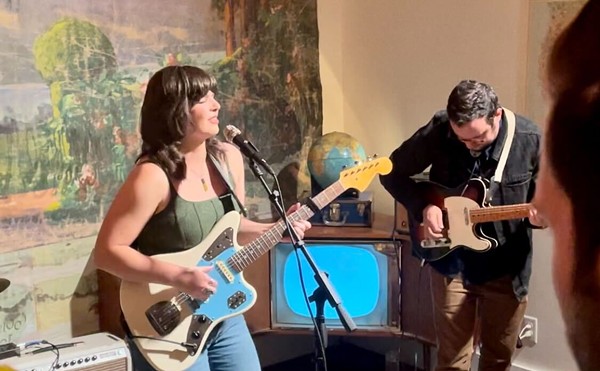La Onda, the first club in St. Louis to specialize in Mexican music, turned one year old last month. "There are about four or five different Mexican styles I book at the club," explains Matthew Mulcahy, owner/operator of La Onda. "There's norte ño (accordion-based and traditionally rooted), musica grupera (eclectic four- or five-piece bands), banda (uncategorizable groups of anywhere from eight to 18 members); then there's cumbia, and the slower, romantic pop bands. Norte ño is really popular. It comes from northern Mexico, which is where the U.S. gets most of its immigrants, and so it's very popular in the U.S. But the banda is also very popular; you'll probably see more banda on television than norte ño, if you're watching the Spanish stations. It's popular with the younger crowd because it's very fast-paced dance music. Norte ño's more laid-back."
La Onda gives an impression that's part high-school sock hop -- clubgoers are young, many just crossing the 18-and-over age line -- part perpetual Cinco de Mayo hard-drinkin' dive. Beer cans pile up in towers on tables -- the club might consider hiring a bar back -- and as the young Mexican-American men work the room, looking for partners (most nights women get in free, but males still outnumber females four or five to on), you catch glimpses of resignation and resilience when they strike out, and, oddly enough, the same resignation and resilience when they succeed.
Compared with other cities its size, St. Louis has a small Latino population, though that community is growing. Mulcahy, who also owns the tropical- music-oriented Club Viva!, knows how long it takes to build a following for Latin music. "I've been doing promotion in town for years and years. I started out doing tropical music at Viva, and that took years of promotion. Initially I had mixed both styles of music, the Mexican and the tropical, but it wasn't as natural a fit as you'd think. The people who liked the salsa were complaining about the Mexican music, and people who like the Mexican music were complaining about the salsa. When I first opened La Onda, I was cautious. I started out with Mexican music only on Saturdays. On Fridays I tried to mix the music a little, with tropical and Mexican together. It never really took off. I tried swing on Fridays, and that never really took off. Everybody complained when I stopped doing it, but they didn't support it enough. Thursdays I was doing reggae, and that wasn't terribly successful." Since then, Mulcahy has moved to pure Mexican music on the weekends, exploring other styles during the week. Judging from the crowds on the weekends, however, La Onda is beginning to develop a connection to both the Latin and Anglo communities. ""La onda' is Mexican slang. It literally means "radio wave,' but when people say "la onda,' it means the ambiance of something. If you say, "This is la onda,' it's like saying, "This is where things are happening.'"
La Onda is the best place in town to hear contemporary Mexican music, but it's not the only one. In St. Ann, the Acapulco Restaurant and Lounge consistently presents live Mexican music and karaoke (not to mention knockout margaritas). The longest-running Mexican band in town -- hell, one of the longest-running bands, period -- Grupo Fantasia, has been keeping a monthly Saturday-night residency at the Acapulco for about three years now. Fausto Rivera formed the group in 1983. "Before that I never liked music so much," he says. "I bought one of these little keyboards with a rhythm box; I was just playing by myself. I started liking it, so me and my nephew Juan, he played drums, and his brother played guitar, so we got together just to see what we could do."
Grupo Fantasia has evolved into a sextet: drums, percussion, electric bass, electric guitar and two keyboards, which blare, blat and whir synthetic chords and right-hand flourishes. If rock critics have a common nemesis, it's that sound: big, paddy -- think new-wavy -- shamelessly digitized, a polyester whine. That's the defining sound of much contemporary Mexican music, and Grupo Fantasia lays it on with a double attack. "That's pretty common now," Rivera says. "The banda bands, they have so many players, a lot of middles, and so having two keyboards lets a small band fill the middle parts. You can do the saxophones and trumpets like the banda groups." Lovers of North American soul music won't cotton to it -- at least not at first. We've been raised on the Hammond B-3, with its extended notes and modulating tone, its eerie reflection of the human voice. When Rivera and fellow keyboardist Benjamin Garcia bounce riffs off each other, their volume and tone are aggressive enough to keep the melodies riding over the double percussion and rowdy crowds, their accents simultaneously feeding on and urging the boxy dance rhythms. No one would mistake their keyboard sound, subtle as a semi's air horn, for a sax and trumpet section, but you wouldn't call it cheesy, either.
Grupo Fantasia has seen members come and go, casualties of drinking, military call-ups -- during the Gulf War, Juan Rivera was sent to the desert; the band carried on using a drum machine -- and the law. They've played blood- letting dives in Alton -- in the '80s, the Mexican-music scene (such as it was) took root across the river -- weddings and parties. They're a great bar band with their psychedelic lights, speaker towers, fog machine and between-song banter, like the rap of all-night DJs spinning the latest Latin craze. Their sets include both originals and hits from hot Mexican bands like Los Tucanes de Tijuana, Grupo Primavera and Grupo Brindis; lots of ebullient cumbias, boleros, baladas; lots of requests for Selena. When they settle into a traditional ranchera, their three- and sometimes four-part harmony is as lonesome as bluegrass. On a popular romantica like "Necesito Decirte," bass player Juan Estrada wails on the swelling chorus, misses half the notes and finds an honest agony. Then percussionist and drummer swap places, guitarist Luis Miranda flings off a Chuck Berry lick and the band tears into a Spanish version of "Jailhouse Rock." Grupo Fantasia suddenly shifts into East LA garage mode, like the Blazers with organ lines; in a thrilling bit of reverse assimilation, a north of the border roots classic finds a south of the border frenzy. St. Louis isn't exactly known for Mexican music this effortless and dynamic, but Grupo Fantasia has been working on it for 16 years. "We play all different styles," Miranda says. "We try to draw people into the music."





